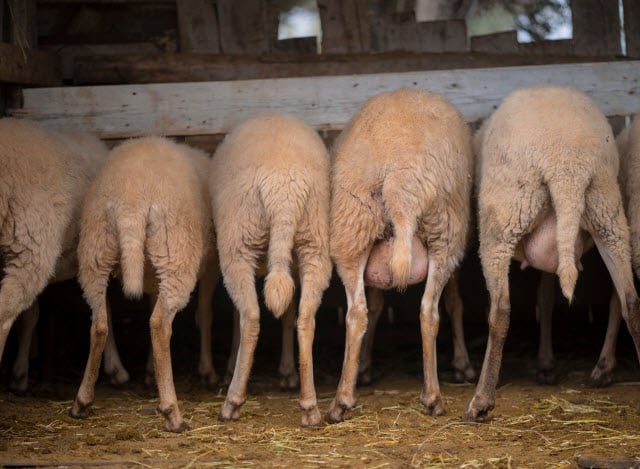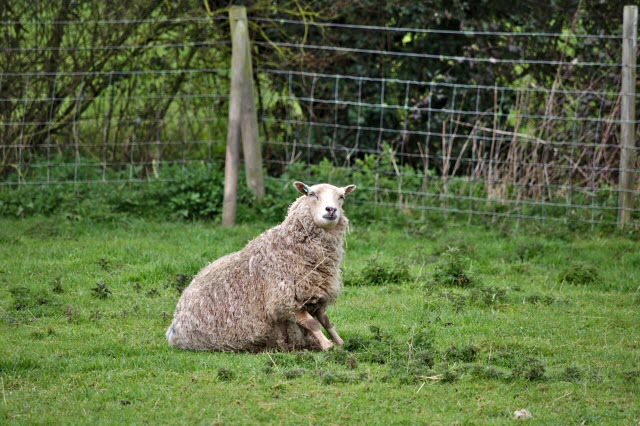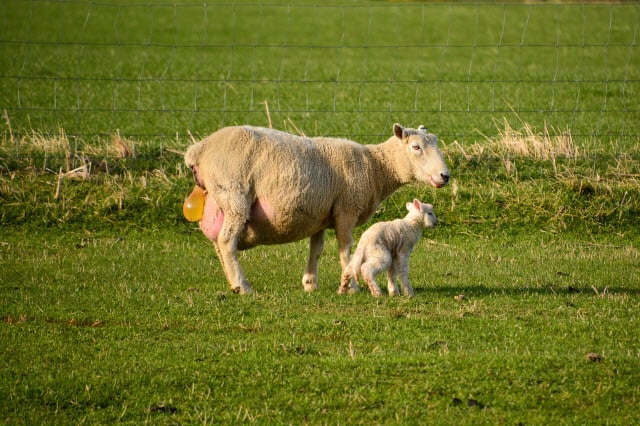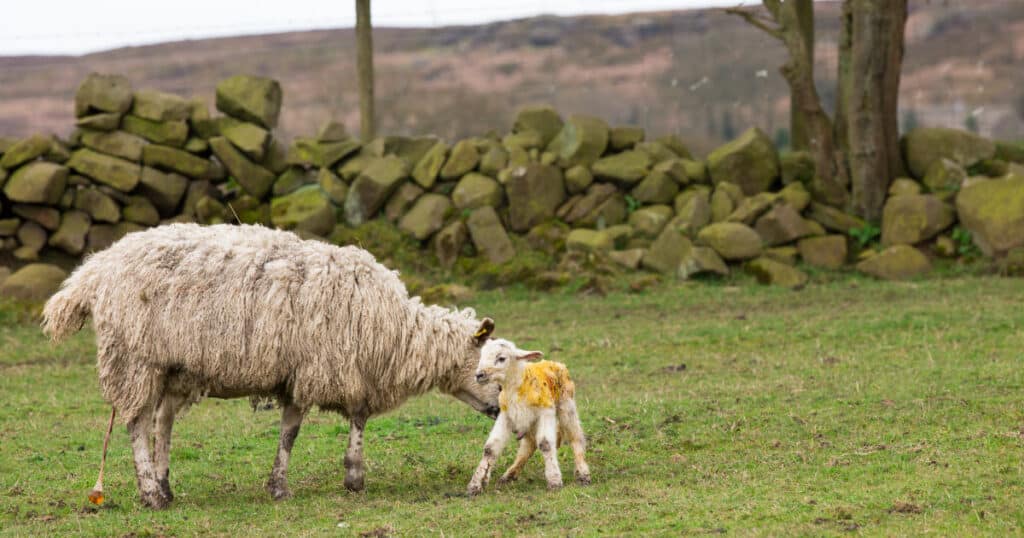There are many resources which detail common sheep lambing signs. Still, we thought it would be useful to offer the most important and the clearest signals in a short and clear list. From changes in behavior (like pawing at the ground) to physical changes like bagging up and the swelling of teats – there are plenty of clear signals that can save you time (and late night trips to the barn) if you know what to look for. Let’s explore how to tell when a sheep is close to lambing.
While using a lambing calculator or sheep gestation table is helpful, when the big day is near watching for these obvious signs of lambing will let you know if your ewe is getting ready.
Sheep Lambing Signs You Need to Watch For
These 5 physical and behavioral late-pregnancy cues are how to tell when a sheep is close to lambing.
By observing your sheep closely on a daily basis, these changes in their appearance and behavior will be obvious.
Bagging Up
Your ewe will start to develop an udder about 4 weeks prior to lambing. As due dates approach, get in the habit of walking behind your ewes when you feed them their grain. Reaching under them to check for the first signs of an udder can tell you a lot.

When you see or feel an udder starting to form, mark the date on your calendar. This will give you a clear sense of when your ewe might deliver.
As that date nears watch their udder closely – within 24 hours of lambing, her udder will become firm and her teats will become large, swollen and filled with milk. The change in appearance of sheep udders before lambing is a clear sheep lambing sign that even beginners can spot.
The change in size and appearance of her teats will not be subtle at all.
Sunken Loin Area
1-2 days prior to your sheep lambing the lambs will “drop” inside the ewe. This means that they’ll be carried lower inside her abdomen as they get into position to be delivered through her birth canal.
When this happens, most ewes appear to have pronounced sunken cavities between their hipbones and last rib.
This happens as the lambs move into position for delivery and is a clear sign of lambing. Usually it’s easy to notice as ewes in late pregnancy appear very large, and when this happens it transforms their appearance overnight.
Pregnant Ewe Stops Eating or Ignores Food
Immediately before lambing it’s common for many ewes to skip a meal while standing off by themselves.
While missing several meals is cause for concern, skipping grain and hay one morning or night is usually a signal that your ewe has other things on her mind: namely delivering lambs.
This change in behavior is typically preceded by the two physical changes listed above, and will happen at the same time as the next behavioral signal that lambing is near.
Nesting and Pawing at Her Bedding
Just before your ewe begins labor it’s common that she will seek out a secluded area and begin pawing at the ground. Some ewes paw gently while others will create huge mounds of bedding in an effort to create a welcoming area for delivery.
This is usually one of the last sheep lambing signs before your ewe goes into the final stages of labor. If you happen to notice a ewe that doesn’t come for her grain or hay, it’s likely she’ll also be nesting if closely observed.

Once labor begins in earnest, some ewes will elevate their front end to allow gravity to help with the delivery.
Passing a Water Bag
Typically your ewe will pass at least one water bag (in humans it’s referred to as a woman’s water “breaking” but in sheep many times the sack of amniotic fluid will remain in tact).
When this happens you know labor has begun in earnest and the first lamb should be delivered within 20-30 minutes. If it takes longer than that after your ewe’s water has broken you may need to assist, although first-time mothers can labor for some time before delivering their lamb(s).

It is not uncommon for ewes to pass several water bags during the labor and delivery process, and these can vary in color and size.
The Importance of Daily Observation
One of the most commonly overlooked aspects of correctly identifying lambing signs in sheep is your regular presence in the barn.
If you aren’t used to your sheep’s routines and appearance you won’t notice the subtle changes which can serve as clear signs your ewe is about to lamb.
To learn more read our in depth article on tips for lambing, and if we’ve missed a common lambing sign that you always look for please share it in the comments below.


i have a ewe that got some food stuck in her throat the other day and i thought she got it cleared. But she isn’t eating now for two days. she is up moving with the herd but is slow and droupy.No signs of runny nose nor runny stool. need advise,please!
Hi Carl,
Not sure from the description – I would contact a vet and separate her from the flock. If she isn’t eating or getting calories you might try mixing some molasses with hot water in a 5-gallon bucket to see if she’ll take that … will give her some calories and energy and could help to turn her around.
My pregnent ewe is going to lamb soon I hope she’ll be ok, because she is smaller then most sheep,and I hope I i’m reddy
Hi Hannah
Just keep a eye on her when she starts, you might have to help.
I have Baby dolls waiting on my to lamb any day now.
I have a ewe and how will I know if she is in labor im not out there all the time so how will I know
Good afternoon, I wanted to reach out to you in hopes of some relief of anxiety of the not knowing. I rescued an older bred haired ewe this Summer (2019). The gentlemen that gave her to me let me know that my only concern with her being pregnant, is that she had been attacked by 2 dogs last Fall of 2018. She wasn’t supposed to get bred. However, a ram got to her and now here I am scared to death that I will not be able to save either of them when the time comes.That is another issue. The man gave me a delivery date of end of November first of December. I know she is getting to deliver because she’s hollow in her HOO HA area, sunken in on both back sides of her hips, her tail looks like its just dangling and she is squatting to urinate and pooping is very often than usual. I have been watching her very close since last Wednesday and everyday she is looking more and more miserable. She is still eating, drinking, but I cant see her Hoo Ha for her tail to see if it’s swollen or red etc( other signs) , but I can see on each side her tail which is hollow. I’m so scared she is going to need assistance and I will not be there when her amniotic bag burst. Is there usually a specific time in the day or night they usually deliver? Or is she at all close to delivering? I check on her every hour when I am home and it’s so exhausting. I don’t want to miss something and it be too late. Any advise would be greatly appreciated!
Thank you,
Corisma
Hi, Corisma
Sorry I’m just seeing this now! I hope everything turned out ok. The biggest sign that lambing is imminent and will happen within days is that their teats will swell and enlarge. When that happens you’re a day or two away usually.
There’s no specific time that sheep like to lamb (though mine always seem to prefer the middle of the night on the coldest night of the month).
If your ewe is acting sluggish or mopey then that could be a warning sign of toxemia, which is dangerous. You can learn more about that on our Sheep Diseases page (see the menu at the top of this site).
Thanks for visiting and commenting!
Joe